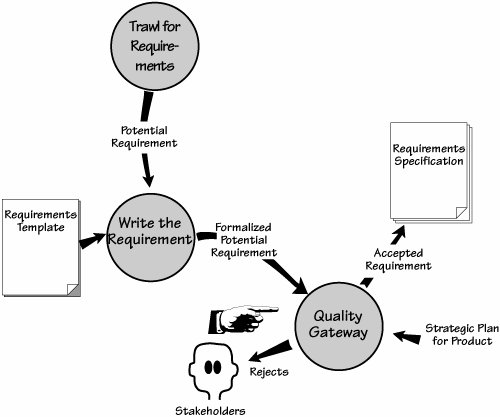Chapter 11. The Quality Gateway
The Quality Gateway is just thata gateway into the requirements specification. That is, each requirement must be tested by the gateway before it may be included in the specification with the other correct requirements.
Consider the life of a requirement before it arrives at the Quality Gateway. The requirement could have originated anywhere or with anyone. You have been using a variety of trawling techniques to discover the requirements. Each requirement is capturedregardless of its completeness or coherencywhenever and however it appears. You catch requirements when they come out of people's mouths, when you observe them, when you read them. Your concern when trawling is to capture all of the requirements and not to miss anything. Your results can take a variety of forms (interview notes, sample documents, blogs, videos, scenario models, and rough sketches in your notebook, among others) and states of completion. All of this seeming randomness makes them difficult to review. At this stage of development, let us call these potential requirements. The writing process we spoke about in Chapter 10 applies the template and the shell to the potential requirements and puts them into a consistent form. Once they are in that form, you can call them formalized potential requirements. This transformation should be thought of as a natural progression from the half-formed idea to a precise, unambiguous requirement. But you have one more thing to do before you can call it a completed requirement: You must test it. When the formalized potential requirement arrives at the Quality Gateway, it should be complete enough that it can undergo tests to determine whether it should be accepted into the specification or rejected. If it is rejected, then it is returned to its source for clarification, revision, or discarding. See Figure 11.1. Figure 11.1.The Quality Gateway is the activity where each requirement is tested to ensure its suitability. "Suitability" in this context means that the requirement provides downstream activities with a clear, complete, unambiguous description of what to build. To ensure a suitable requirements specification, all requirements must be tested by the Quality Gateway. For a detailed process model of the Quality Gateway, refer to Diagram 4 and its supporting material in appendix A. This chapter discusses the Quality Gateway as an activity within your requirements process. However, this activity is slightly different in that it is brought into play as each requirement is written: The requirement is tested and, if accepted, becomes part of the specification. You should also consider the effect of the Quality Gateway: When requirements analysts know the standards the gatekeepers use to test the requirements against, the analysts can use the same tests to improve their own requirements writing. Keeping the Quality Gateway tests in mind helps analysts raise questions earlier and improve the quality of the requirements that eventually pass through the formal Quality Gateway. |
EAN: 2147483647
Pages: 371
